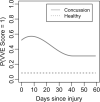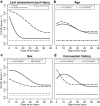Trajectories of Visual and Vestibular Markers of Youth Concussion
- PMID: 35785959
- PMCID: PMC9529314
- DOI: 10.1089/neu.2022.0014
Trajectories of Visual and Vestibular Markers of Youth Concussion
Abstract
Visual and vestibular deficits, as measured by a visio-vestibular examination (VVE), are markers of concussion in youth. Little is known about VVE evolution post-injury, nor influence of age or sex on trajectory. The objective was to describe the time trend of abnormal VVE elements after concussion. Two cohorts, 11-18 years, were enrolled: healthy adolescents (n = 171) from a high school with VVE assessment before or immediately after their sport seasons and concussed participants (n = 255) from a specialty care concussion program, with initial assessment ≤28 days from injury and VVE repeated throughout recovery during clinical visits. The primary outcome, compared between groups, is the time course of recovery of the VVE examination, defined as the probability of an abnormal VVE (≥2/9 abnormal elements) and modeled as a cubic polynomial of days after injury. We explored whether probability trajectories differed by: age (<14 years vs. 14+ years), sex, concussion history (0 versus 1+), and days from injury to last assessment (≤28 days vs. 29+ days). Overall, abnormal VVE probability peaked at 0.57 at day 8 post-injury, compared with an underlying prevalence of 0.083 for uninjured adolescents. Abnormal VVE probability peaked higher for those 14+ years, female, with a concussion history and whose recovery course was longer than 28 days post-injury, compared with their appropriate strata subgroups. Females and those <14 years demonstrated slower resolution of VVE abnormalities. VVE deficits are common in adolescents after concussion, and the trajectory of resolution varies by age, sex, and concussion history. These data provide insight to clinicians managing concussions on the timing of deficit resolution after injury.
Keywords: brain injury; neurofunction; pediatric; time course.
Conflict of interest statement
No competing financial interests exist.
Figures


References
Publication types
MeSH terms
LinkOut - more resources
Full Text Sources
Medical

